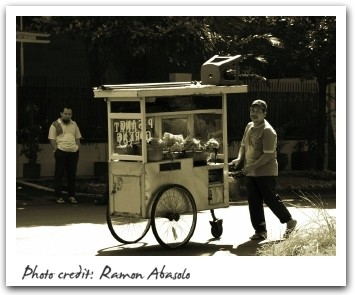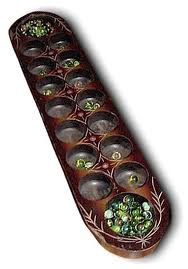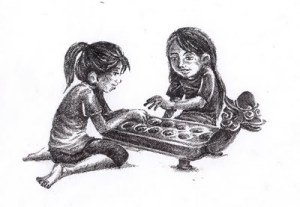how are you? great to hear that you are fine.
Are you looking for some fun about Indonesia ? with a lots interesting fact and bit of information all about Indonesia you will learn a lot of things you didn't know!
People or relgion
Living on more than 13,400 islands, the Indonesian nation today counts some 200 million population comprising more than 200 ethnic groups. After Independence in 1945 inter-marriages among people of different ethnic groups have welded the population into a more cohesive Indonesian nation.
- The majority of the population embraces Islam, while in Bali the Hindu religion is predominant. Whereas in areas like the Minahasa in North Sulawesi, the Toraja highlands in South Sulawesi, in the East Nusatenggara islands and in large parts of Papua, in the Batak highlands as well as on Nias island in North Sumatra, the majority are either Catholics or Protestants. On the whole the Indonesian people are religious in nature.
- And, true to the Pancasila, the five principles of nationhood, - namely Belief in the One and Only God, a Just and Civilized Humanity, the Unity of Indonesia, Democracy through unanimous deliberations, and Social Justice for all - Indonesian societies are open and remain tolerant towards one anothers religion, customs and traditions, all the while faithfully adhering to their own. The Indonesian coat of arms moreover bears the motto:Bhinneka Tunggal Ika Unity in Diversity.
- Although todays youth especially in the large cities is modern and follow international trends, yet when it comes to weddings, couples still adhere to traditions on the side of both the brides and bridegrooms parents. So in a mixed ethnic wedding, the vows and wedding traditions may follow the brides familys, while during the reception elaborate decorations and costumes follow the grooms ethnic traditions, or vice versa. Weddings and wedding receptions in Indonesia are a great introduction to Indonesias many and diverse customs and traditions. Weddings are often also occasions to display ones social status, wealth and fashion sense. Even in villages, hundreds or even thousands of wedding invitees line up to congratulate the couple and their parents who are seated on stage, and then enjoy the wedding feast and entertainment.
- indonesian children on Bali are traditionally always given at least four names
Environment
- Adult male orangutans, found in the wild only on the Indonesia islands of Borneo and Sumatra, are said to be eight times stronger than a human.
- Indonesia is the only country to see the Komodo dragon, the world’s largest lizard, in the wild. One theory holds that the Chinese dragon is based on the Komodo dragon.
- One of Indonesia’s most interesting critters is the tiny nocturnal primate called the tarsier. These creatures, found on Sulawesi Island, are recognizable by their eyes, which are literally as big as their stomachs, so big they cannot rotate them in their sockets. Luckily, their heads can rotate 360° to compensate.

- Indonesia is home to the Rafflesia arnoldii, the world’s largest flower, which may be the world’s stinkiest flower as well, and Amorphophallus titanium, the world’s tallest flower.
- Arguably one of Indonesia’s stranger exports is Kopi Luwak (Cat Poop Coffee), which is the world’s most expensive beverage, costing around US$1,000 per pound. Kopi Luwak is made by feeding small, catlike civets coffee berries. After they defecate, the berries are collected, washed, and ground into coffee, which supposedly has an unrivaled richness and little bitterness.
Festival
Being a diverse country of origins and religions, Indonesia have a good mix cultural events, ceremonies and festivals. come and experience the Indonesia festival all year round, as you can see you will never be short of choices.
having population of more than 230 million people, even the 'minorities of people will have large enough celebrations. Here you can find for religious event for Muslim, and then Buddhist, Christians and the rest of more local festivals, ceremonies or art and cultural events, some celebrated by the nation while most unique to local areas or regions.
- Ramadan.Having a large percentage of people who are Muslim, approximately 86% of its population, Ramadan is celebrated widely here all across Indonesia. Ramadan is the ninth month of the Islamic calendar where the Muslims will fast during the day for an entire month. The month of celebration is base on the Islamic calendar, therefore changes every year.
- Id-al-Fitr.Follow from the fasting, the Muslims will end it with a huge celebration for three days following it.
- Eid al-Fitr.This is when the Muslims commemorate birth of Prophet Muhammad, with week-long festival of gamelan performances and parade of floats.
- Independence / National day.The Indonesians will celebrate their Independence day on 17th August, and this their biggest national festival. Usually there will be a grand parade before the President in Jarkata, the capital of Indonesia.
- Christmas.Despite being only 8% of the population who are Christian, it is still a significant amount of people with it being a popular festival and a national holiday in December. Here you will find usual Christmas celebrations of markets and shops selling gifts and accessories while many places organized party and celebrations.
- Nyepi, literally means ''Day of silence, is the day of the Balinese New Year, Commemorated every Isaawarsa(Saka new year) base on Balinese calender, thefore changes every year but genarally in March. On this day you will fnd everything is closed in Bali as it is a day of fasting and meditation. But on Gods, pray hold ceremonies and verious other rituals. Read more on Nyepi in Bali Festival
- Toraja Funeral Ceremony.At Tana Toraja, you may observe their famous Toraja Funeral Ceremony. The Toraja people, who lives in the highlands of South Sulawesi, does elaborate and fascination funeral rites to send the spirit of the dead to the after-world in order to prevent misfortune on the deceased family. Usually between July to September, Toraja from all over Indonesia will return to celebrate these annual funeral rituals
- Baliem Valley Festival unique only to the Papua people, tracing its root in the belief, held by the various local tribes, that war is not a just a conflict but also a symbol of fertility and prosperity. Celebrated in August, the main event is the mock-war between the local tribes, with more than 20 different tribes, each with 30-50 people, clad in traditional clothing and fighting gears. There will also be side performances and attractions of local traditional games, dances and local food showcase. It is definitely a rich and unique celebration in the Baliem Valley of indigenous culture.
- Kesodo (Kasada) Ceremony.Hundreds of thousands of Tenggerese will gather at the famous Mount Bromo, an active crater in East Java, Indonesia, during the month of August. In order to ask for blessings and another year free of eruptions, the people will present offerings of rice, vegetables, fruits, animals and other local produces to the God of the Mountain.
- Pasola.During February or March, Pasola will be celebrated in various locations across East Nusa Tenggara. Every year there will be announcement on where and when the celebration will be done. This is one of the most exciting Jousting Festival, well known around the world, where people on horseback without saddles will throw spears (know as hola) at each other to unseat the opponent. It is a traditional Sumba ritual sport to keep the spirits happy and to bring good harvest.
- Waisak (Vesak).In commemoration of the birth, enlightenment and death of the Gautama Buddha, the Indonesian Buddhist will usually observe this special day sometime during the full moon of May / June. During Waisak in Borobudur, the largest Buddhist monument in the world, the day will be grandly celebrated by thousands of monks and pilgrims. Centered at the three Buddhist temples, there will be a ceremony of walking from Mendut to Pawon and ending at Borobudur.
- Galungan.This important Hindu festival in Bali, it is celebrated for the coming of the gods and the ancestral spirits to dwell in the home of their descendants. During this festival, Hindus will dive off evil spirits with incantations and firecrackers, while express gratitude to their Gods by inviting them down to earth by celebrations of offerings, dancing and new clothes.
SPECIFIC PLACES IN INDONESIA FESTIVALS:
- Jalan Jaksa Festival. At the capital of Indonesia, Jakarta, you may at least find a festival worth a visit. It usually takes place in July / August, where you can find the street close to all traffic and replaced with food stalls, craft workshops, street artists and musicians. You may try food from all kind of Indonesian specialties while immerse in the rest of the art shows like traditional martial art combat or Betawi orchestra. You may also find batik making workshops in the midst of it all.
- Festival Teluk Kendari.In April, there will be partying and dragon-boat races in Sulawesi’s Kendari Bay.
- Bidar Race. In August, you can find lots of vivid bidar (canoes) race in Sumatra’s Sungai Musi.
- Bali Arts Festival. Largest annual celebration of art and culture in Indonesia, with a full month (between June-July) of daily performances, arts exhibitions, dances, food and other cultural offerings. Read more about this famous Bali Arts Festival. It is important to search for a cheap Bali hotel a couple months before this festival since they will increase their rates a few weeks to a month before.
- Yogya (Jogja) Arts Festival. In June – July, you will find shows and exhibitions in the Java’s cultural capital Yogyakarta.
- Krakatoa festival. Annual festival held in Lampung to celebrate the volcanic island called, you guess it, Krakatoa. There will be performances, elephant procession and assorted dances in the town with the finale of the event is a trip to the active volcanic island itself

- Bau Nyale Fishing Festival. In February or March, hundreds of people will rush to Lombok to catch a glimpse of the first nyale (wormlike fish) at the huge fishing festival. The indigenous Sasak people of Lombok will commemorate a mythical princess who had drown in these waters to escape a politically arranged marriage. This festival is done the same time with the season of these wormlike fish, where they are caught and eaten roasted in banana leaves with much enthusiasm.
food
| Typical meal: A typical Indonesian meal consists of steamed rice and one or two main dishes made of fish, meat, chicken or vegetables, sometimes including soup, all of which are served together. A common side dish is sambal. Manner of eating: Food is eaten with the fingers or with a spoon and fork. When eating with the fingers, Indonesians use their right hand only. The left hand is used for less hygienic matters. They always leave some food on the plate or drink in the glass to indicate that they have had enough.  Hawker food: For a quick bite, there are street vendors peddling their food on their 3-wheeled carts. These stalls are known as kaki lima. Many of these vendors have their own distinctive calls (a beat on a piece of wood, a yell or a bell) to announce their wares ranging from drinks, sweets, rice and noodle meals. Each kaki lima vendor sells only one dish and many sell mee bakso. Hawker food: For a quick bite, there are street vendors peddling their food on their 3-wheeled carts. These stalls are known as kaki lima. Many of these vendors have their own distinctive calls (a beat on a piece of wood, a yell or a bell) to announce their wares ranging from drinks, sweets, rice and noodle meals. Each kaki lima vendor sells only one dish and many sell mee bakso.Favorite foods: A popular Indonesian dish is satay (pronounced sah-tay) served with peanut sauce, ketupat (pronounced ke-too-paht), cucumber and onions.
Desserts often consist of tropical fruits such as starfruit, mangga (mango), manggis (mangosteen), rambutan, durian and nangka(jackfruit). Indonesian desserts are often made from glutinous rice flour, palm sugar and coconut milk. Some favourites are kueh lapis, bubur hitam and es campur. |
In general, the people wear clothes that are similar to western style. They wear traditional dress on special occasions.
Men: Indonesian men generally wore sarongs (usually with a checkered pattern) in the home. In public, the sarong is worn only when attending Friday prayers at the mosque. For formal national occasions, the men wear batik shirts with trousers or teluk beskap, a combination of the Javanese jacket and sarong.
Women: For formal occasions, Indonesian women wear the kebaya -- a beautiful, figure-hugging embroidered blouse worn with a batik sarong that is usually dyed with flower motifs and in bright colours. On these occasions, women often tied their hair into a bun, or attached a false hairpiece. In addition, they may drape a long stretch of cloth, called "selendang", over one shoulder. This cloth can be used as a head shawl or on less formal occasions, used to carry babies or objects.
Traditional Dress: Indonesia has 300 ethnic groups; each has their own traditional dress variations.
- The Minangkabau ethnic group is indigenous to the highlands of West Sumatra. Their traditional dress consists of silk robes with metallic thread woven into the material. Their headdress is shaped like buffalo horns.
- The Toraja people live in the mountainous areas of South Sulawesi (Celebes). The women's traditional costume features elaborate beadwork and tassels.
On this era, for some kids traditional games do not look attractive anymore, they prefer playing the Internet, video games, Play Station etc. Whereas this traditional games can form the character of the child to be creative, innovative,socially minded, cultured, and faithful. So sad that this traditional games slowly become extinct
Indonesian traditional games , such as:
- GASING we can found it in almost all region of Indonesia. Gasing commonly played by boys with age 7 – 17 years old, and it could be played in group. Gasing was made from woods, formed with a taper section in the bottom. This is a competitive games, testing skill on rotating the Gasing.
- Kuda Lumping. These small replicas of the larger kuda lumping that are used in a trance dance on Java are cut out from wovenbamboo mats and painted with striking colored patterns. Sequins, beads and other materials can also be added to give the kuda lumping its colorful appearance.When given to a child, their imaginative minds are the only limit as to what dramas these kuda lumping are the center of! Although intended as a toy, many of these delightful horses end up in suitcases to be given as souvenirs of an expat's trip to Indonesia or smaller more colorful versions can be used as eye-catching decorations on Christmas trees.

- CONGKLAK played by 2 people. Congklak need Congklak Board (Papan Congklak) and 98 seed/clam shell/little stone or marble. The game started with one people take any seed from any hole and put it on the next right hole and so on. If the seed is run out in the rival small hole, we can take all the seed on the hole. And if the seed run out in our side of the board, we can take all the seed in opposite hole. The game can be considered over if there’s nothing left to be taken (all seeds are in the 2 big hole). And the winner is a person that get the most seeds.


- BALAP KARUNG is one of the popular games in Indonesia. Players must be put their feet on the sack, and jump to race on until finished line.
- GALAH ASIN consist of 2 groups, and each time have- 5 players. The point of the game is facing the opponents so the opponent can not pass through the last line back and forth, and to win the game, the entire group should complete the process back and forth within a predetermined area of the field
- EGRANG this game can be categorized as child games. Commonly the game played with boys, age 7-13 years old. And the players are 2-6 people.

Thankyou for read this post,
so take care and always smile
weeeee :)














No comments:
Post a Comment